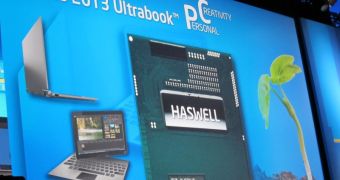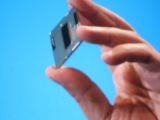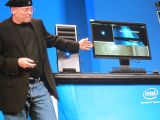Intel keeps revealing new and exciting information at IDF 2011 as the company has recently showcased the first pictures of its upcoming Haswell processor that is expected to be released in 2013 as a replacement for Ivy Bridge.
The chip was presented by none other than Mooly Eden, VP, general manager of PC Client Group at Intel during a keynote presentation held at IDF.
During the same presentation, Mooly also revealed that Haswell notebook processors are designed to have TDPs between 10 and 20 Watts, a significant reduction when compared to the 35 – 45W of Sandy and Ivy Bridge CPUs.
The low power draw, together with the configurable TDP technology that will debut in Ivy Bridge, is expected to enable laptop makers to offer up to 10 days of connected standby battery life from their Haswell-based devices.
According to AnandTech, dynamic overclocking will also play a major role in Haswell, which is expected to receive an enhanced version of the Turbo Boost functionality available today in Sandy Bridge.
No other information about Haswell was released during the keynote, but from past reports we know the chip will be built using the Tri-Gate 22nm fabrication process and that it will be designed as a system-on-a-chip (SoC) device.
Intel has already taken a step in this direction with its current Sandy Bridge processors that incorporate not only two or four computing cores, but also a graphics core and all the controllers that were traditionally found inside the north bridge chipset (ie. memory and PCI Express controllers).
GPU performance will also be increased by a significant degree and Haswell will get support for DirectX 11.1.
In addition, the processing cores will deliver better performance than the current CPU designs, thanks to the inclusion of support for the AVX2 instruction set as well as to a series of IPC improvements. (via Hardcore Hardware)

 14 DAY TRIAL //
14 DAY TRIAL // 

